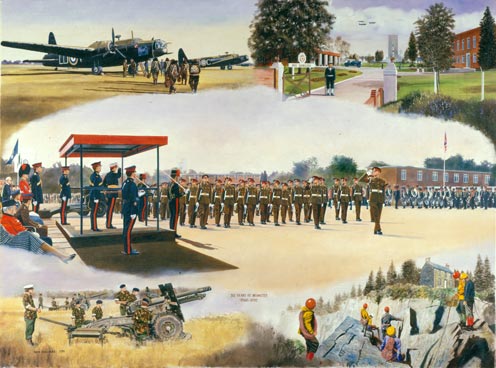| |
« Click on Picture to
Return » |
|
|
 |
|
50 years at Bramcote 1940-90
Bramcote, in Warwickshire, is one of the few military stations which have been occupied by all three of the armed services. Bramcote was planned as a bomber training airfield for the Midlands during the Royal Air Force expansion period in the late 1930’s. Construction work started in the early part of 1939, and the airfield opened on 4th June 1940 in No.6 Bomber Command.
Bramcote saw the formation of the first Polish-manned bomber squadron in the RAF: No 300 (Masovian) on 1st July 1940. No 301 was formed on 22 July, and in August Squadrons 304 and 305 were formed. In summer 1940 the establishment of aircraft was 54 Wellingtons and 9 Ansons. On 14 November, No 18 Operational Training Unit (OTU) arrived at Bramcote. The first Polish pilots began flying Wellingtons on 1st January 1941.
In November 1946, the airfield was handed over to the Royal Navy and was renamed Royal Naval Air Station, Bramcote, HMS Gamecock, its badge being a Gamecock proper with the motto ‘Spurred for the Skies’. The White Ensign was hoisted for the first time about as far from sea as was possible in England. The station provided technical training for naval Airmen Aircraft Mechanics. In addition, 1833 Squadron of the Royal Naval Volunteer Reserve (the City of Birmingham Squadron) flew Seafires, and later, Sea Furies from here. In March 1957, the entire Air Branch of the RNVR was disbanded and operational flying ceased.
In spring 1959 Bramcote was taken over by the Army, when the Junior Leaders Regiment Royal Artillery (JLRRA) arrived from Hereford. It became a three-battery regiment (33, 39 and 77 Batteries). New buildings were erected in the 1960s, and the airfield as such slowly disappeared, much of it being converted to sports pitches. The barracks retained the name ‘Gamecock’ and the ‘ship’s’ bell still hung outside the guardroom. The JLRRA was the army training establishment for the future non-commissioned officers of the Royal Artillery.
At the end of the annual intake’s period of instruction there was a passing out parade known as Goschen Day (in memory of Lt Goschen who was killed in World War II). I was present at the parade on 17 June 1989, marking 30 years of the Junior Leaders Regiment RA at Gamecock Barracks. It is the central scene in this painting. The Inspecting Officer was Maj.-Gen. H.Y. La R. Beverley, OBE, Chief of Staff, The Commandant General Royal Marines.
Other scenes depict Polish aircrew and their Wellington bombers; the entrance to HMS Gamecock; gun drill with 25-pounders; and adventure training exercises based at Relt cottage, Dolwyddelan, Snowdonia, North Wales.
The Junior Leaders Regiment RA was disbanded in 1993.
Commissioned by The Junior Leaders Regiment RA.
Medium: Oil on Canvas
Printed image size(s): B3 only (approx 43 x 27 cm)
Owner: Royal Artillery
Price(s): £70
|
|
| |
|
|
|
|
|
|
|
|
|
|
|
|
|
|
|
|











